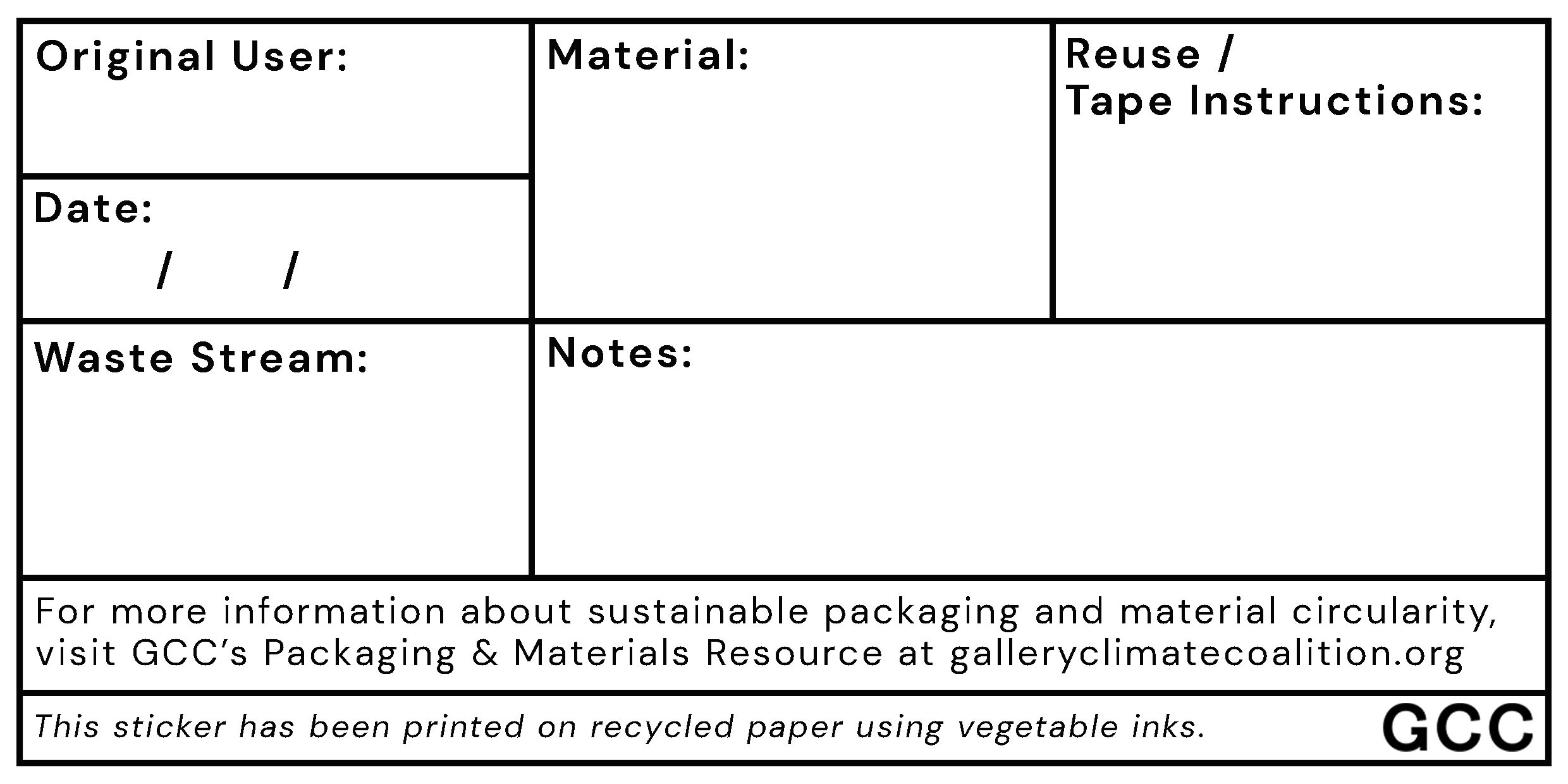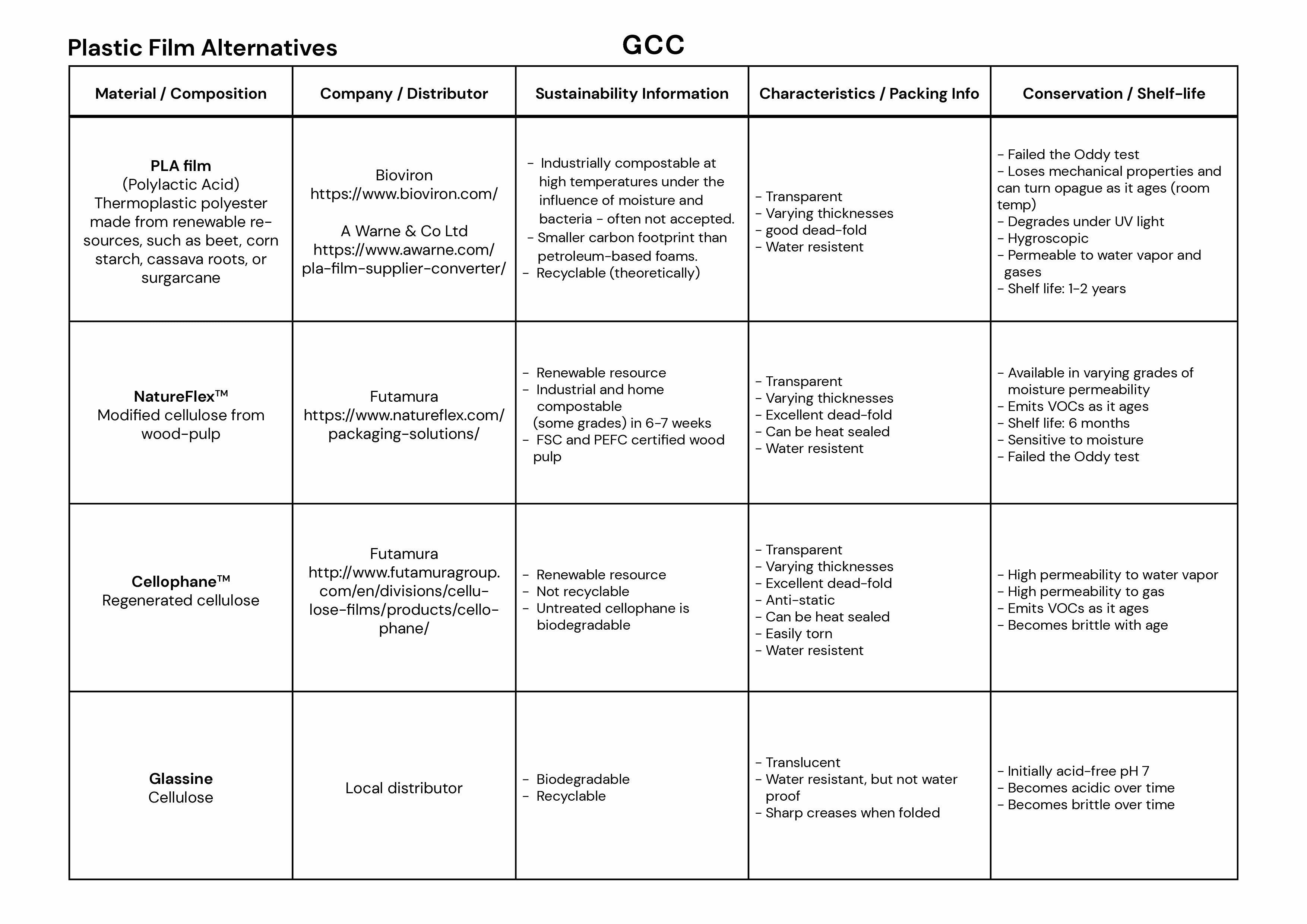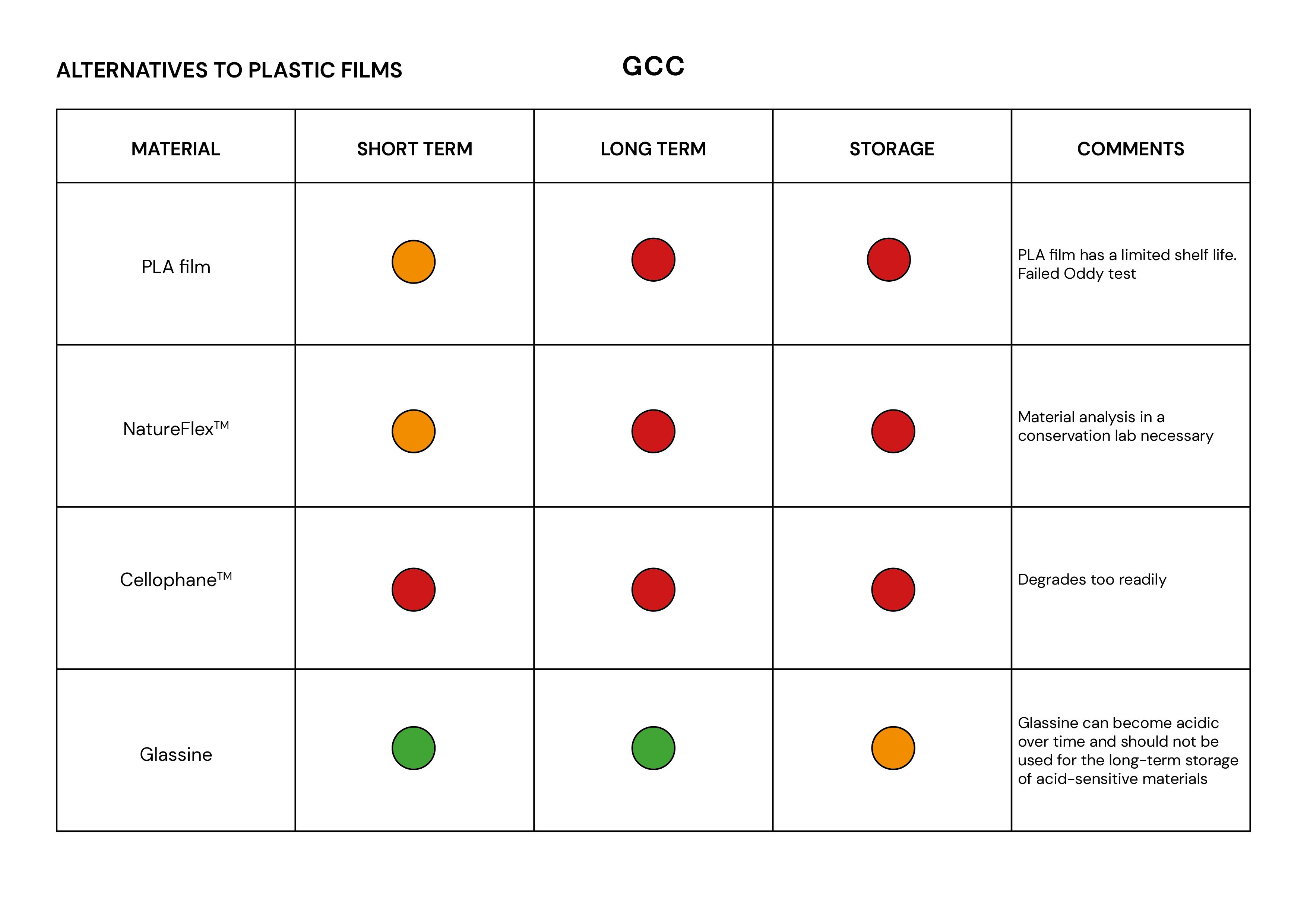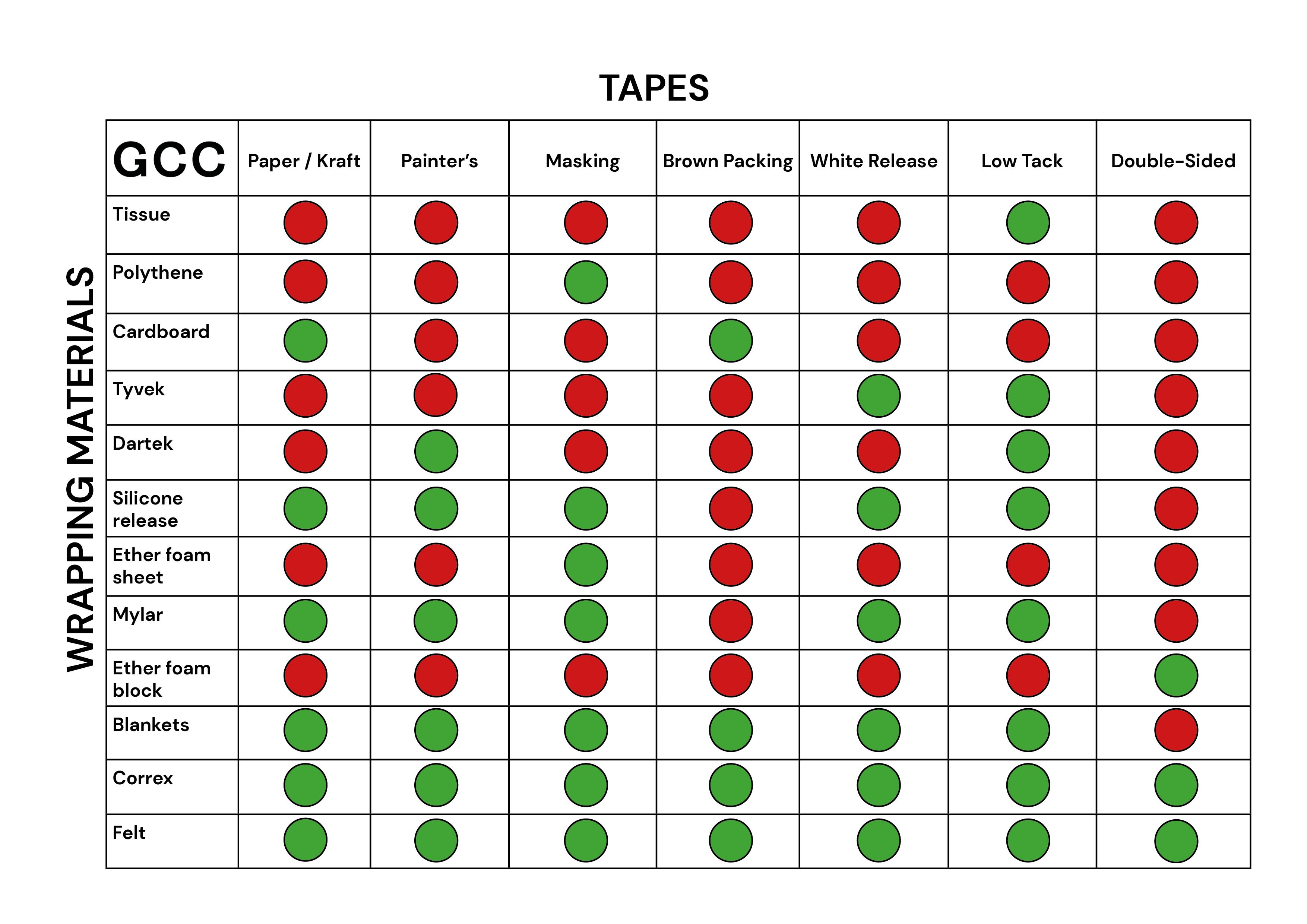-
Overview
- All packaging materials produce Greenhouse Gases (GHG) emissions and waste, even if they are biodegradable or compostable.
- The most critical issue to consider is the afterlife of discarded packaging. Many one-use plastics such as bubble wrap and plastic tape end up in landfills or oceans.
- Best practice for materials will always be Refuse, Reuse, Reduce, Repurpose, Recycle.
- 'Eco-friendly' alternatives for commonly used materials are preferable, but care must be taken to ensure that these products are sustainably produced and are as free as possible of embedded economic and social inequalities within their production chains. It is important to research the origin and manufacturing processes (as well as carbon footprint and life-cycle sustainability) of any packaging material.
- A product's eco-nature is dependent largely upon what local disposal or reuse services are available. All materials must be disposed of properly. See here for more information on recycling.
- Packaging increases the transport weight of an artwork, creating a bigger shipping footprint - especially if being flown.
- 'Traditional' packing materials such as glassine, paper, recycled card, quilted blankets and cotton straps can be reused many times and therefore should be prioritised.
- Overall, reducing materials as much as possible is the best step towards sustainable packaging.
-
IntroductionMany ‘green’ or ‘eco-friendly’ plastic alternatives now exist on the market but their viability as packing materials depends on the nature of the artwork, as well as the mode and length of the journey or storage period.
Whilst these materials can be viable replacements for short-term use, due to their organic composition they will disintegrate quicker than plastics, making them inappropriate for long-term protection of artwork in storage. Organic materials are more prone to mould, acidification, off-gassing, and pest infestations, which do not generally affect non-organic materials.
It is helpful to think about materials as either Archival or Non-archival. The GCC Plastic Alternative Materials Research document gives examples of these items and GCC’s Alternative Materials Correct Usage document advises on how best they can be used.
Currently, aside from archival paper, no plant-based packing materials have been approved by conservators for use in long term art storage. This means that for now we still rely on some plastics. Rethinking packing methods and implementing techniques for reducing and reusing synthetic packing materials is the current best practice and will minimise the amount of waste produced.
Following the 10 Steps to Sustainable Art Packing and ‘Five Rs’ will help to drastically reduce the impact of the plastics. Additionally, the GCC Tapes Chart shows which tapes can be used with which materials in order to extend their lifecycle and avoid unnecessary waste. GCC Banned Materials should be taken out of circulation and avoided entirely.
-
Alternative Packing Materials and Their Correct Uses
Before purchasing and using any material it is important to understand their properties and exactly what context they will be used in. Refer to GCC’s Plastic Alternative Materials Research and their correct uses prior to placing orders. If there is any doubt about the suitability of a packing material for an artwork, contact a conservator or experienced art handler.
Plastic Alternative Materials Research:
For short-term, one-way packing scenarios, non-archival, bio-based packing materials offer a great alternative to synthetic packing materials. Many compostable or biodegradable plastics have recently entered the market and the jury is out on whether these materials are considered best practice in terms of sustainablility and as packaging solutions. These products are new and the impacts still need to be better understood. GCC is working with conservators to conduct the necessary tests to approve their use in an art context.
Similarly, there are many new organic packing materials using fungi / corn / seaweed / hemp that would fully compost in a matter of days and might entirely replace plastic foam products in goods packaging. However, there are currently no plant-based materials that have been approved by conservators for long term art storage. This means that for now we are still reliant on some plastics and bio-based materials. As a result it is necessary to find the most sustainable ways of using these materials and the most responsible ways of procuring them.
Alternative Materials Correct Usage:
It is important to note that ‘bio-based’ does not necessarily indicate biodegradability or compostability. A supplier might claim their product is ‘biodegradable’ but it still might take centuries to degrade. Similarly, many so-called ‘compostable’ plastics require industrial compost facilities, that typically do not accept compostable plastics with organic waste. Improper disposal of ‘biodegradable’ and ‘compostable’ materials can be as environmentally damaging as standard plastic waste. Consider how a material will be disposed of before purchasing it.
Be aware of which tapes are used with a particular material. Correct combinations can avoid the need to cut into materials when unwrapping, allowing them to be saved and reused many times. This simple step will significantly reduce the need for new products to be added to circulation. Follow the GCC Advised Tape & Wrapping Material Combinations chart to extend the life of packaging supplies. Consider this document before making purchases.
Advised Tape & Wrapping Material Combinations:
-
Banned Packaging Material List
GCC has ‘banned’ the following materials that are highly damaging to the environment and should be taken out of circulation and appropriately disposed of as soon as possible. Suitable alternatives exist so there is no reason to purchase them (GCC's International Volunteer Teams have researched alternatives available in London and Berlin). Talk to shippers and suppliers and instruct against receiving goods packed in these materials:
- Polystyrene (Styrofoam™, Foam ‘Peanuts’)
- Single use plastic
- Bubble wrap
- Plastic film
- Single use sheet foam / polyethylene roll
-
The ‘Five Rs’
For now, it is necessary to use some plastics for long term storage but by rethinking packing methods and implementing techniques, the volume of materials can be minimised and therefore the impact of plastics used is drastically reduced.
The Five Rs of waste hierarchy give best practice guidelines for material use: Refuse, Reuse, Reduce, Repurpose, Recycle.

Refuse
- Tell suppliers not to use unnecessary packing materials. Inform them of GCC’s Banned Materials List and ask them to use alternatives.
- Refuse single use plastics. If a synthetic material must be used, make sure it can be reused multiple times.
- Innovate packing methods so that minimal materials are required. Try fixing objects mechanically with bespoke crating, using cotton or nylon straps to secure objects without the need for foam materials.
- Substitute synthetic packing materials for natural biodegradable products wherever possible.
Reduce
- Rethink the amount of packing materials required for safe transport.
- Set a target to half the amount of packaging ordered over the next year.
- Ask framers and other suppliers to minimise their packaging, especially for short journeys.
- Use custom or appropriately sized boxes to avoid filling empty space with excessive materials.
Reuse
- Employ proper packing techniques to ensure the reuse of the materials. Take pride in using materials efficiently and sustainably.
- Maintain cleanliness to prolong the life of the synthetic packaging materials: Wipe down working surfaces before packing artworks and keep packaging materials in containers and away from dust and dirt. Regularly clean storage areas.
- Refer to the Advised Tape & Materials Combinations Chart in order to extend the life of wrapping materials.
- Tyvek is a highly versatile material. With appropriate care it can be reused many times:
- Be aware of which tapes are compatible with what kind of materials to minimise damage and allow maximum reuse.
- Tyvek is two-sided. Knowing which side is which will allow correct use.
- Tyvek can be washed with a damp cloth.
- Label packing materials with instructions for reuse.
- Circulate materials for reuse. Prioritise reusable fine art packing materials such as crates and pouches.
- Traditional materials such as blankets, cotton straps and glassine are reusable and low impact.
Repurpose
- Start a ‘scraps bin’ for material off cuts.
- Store received materials and adapt for future use.
- Repurpose art packaging materials for regular packaging needs.
- Repurpose cardboard into softpacks for framed artworks.
- Turn Tyvek and foam scraps into support cushions for crate padding.
- Share materials that are no longer suitable for art packing with studios, local schools or community centres.
Recycle
- Recycling isn’t as commonplace as one may think. Most municipal recycling facilities are not equipped to sort the different polymer groups and often incinerate plastics instead of recycling them.
- Plastic bags, films, and wraps are not kerbside recyclable because they jam the machinery at recycling facilities. Synthetic foams and Tyvek are also not typically kerbside recyclable. However, various recycling programs are available for these materials, depending on location.
- Refer to the GCC Recycling resource or your regional GCC sub-site for more information on recycling programmes.
-
Reusable Packing Materials for the Art Sector
There are now many companies providing reusable packaging materials specifically for the art sector. Whilst these are likely to be made of synthetic materials they are highly durable and will drastically reduce the need for single use equivalents. GCC advises using these items as long as they remain in circulation for as long as possible and can be recycled through commonly available waste streams at the end of their life.
Reusable Art Pouches:
Reusable Art Crates:
Reusable Frame Corners:
GCC has no formal association with any of these companies and does not receive any benefits for promoting them. Let us know if there are other examples of quality, reusable packaging for a fine art context: info@galleryclimatecoalition.org.
-
Life Cycle Analysis
A Life Cycle Analysis (LCA) is a way of evaluating the environmental impact of a particular product through its life cycle from resource extraction and processing of the raw materials, to manufacture, distribution, use, recycling, and final disposal.
Speak with suppliers and waste management companies about this. They should have information about the impact of specific products.
-
Material Labelling
GCC strongly recommends labelling materials with appropriate information (following the examples below) so that they can be used multiple times and be correctly disposed of at the end of their life.

The use of reused or repurposed materials might not conform to client’s expectations of pristine artwork wrapping in abundant virgin plastics. From conversations GCC has had with art technicians and sales directors there seems to be a hesitation in changing current packing methods due to an anticipated displeasure from the clients if high-value art works were delivered in ‘messy’ or ‘used’ packaging. These perceived hurdles can be quickly overcome by attaching a material reuse label to the work, as below. If further justification is required members can point to their commitment to the GCC GHG emission and waste targets as the reason behind the changes.

-
Circularity: The Path to Zero Waste
The current linear economic model is ‘take, make, dispose’. Environmental sustainability is not possible unless we change the way we consume.
The art sector has a problem with packaging consumption and disposal. To solve this issue new systems based on innovation, clearly defined responsibilities and circularity are urgently needed.
Circularity is a new and quickly evolving field. In the next few years there will be a significant shift in how materials are consumed which means that whoever introduces packaging materials into the system would remain responsible for it throughout its lifecycle. Until these systems are widely implemented at a legislative level, GCC advises members to:
- Eliminate unnecessary packaging. Refer to GCC Banned Materials List for items that should be eradicated from circulation.
- Educate staff and share new methods of operation throughout the supply chain. Communicate not only the importance of zero waste targets but also the methods by which they can be implemented.
- Innovate and support the development of truly sustainable materials so that all products used are reusable, recyclable or compostable.
- Circulate materials so that they remain within the system as long as possible.
Materials that cannot be eliminated or reused must be collected, sorted, recycled or composted after use. Improving and scaling these systems is a key challenge to achieving a Circular Economy. The same circular theory applies to exhibition furniture, equipment and artwork crates:
-
Reuse to the point of failure. Be aware of the items in your inventory and make plans around them. Do not purchase materials or equipment that cannot be used multiple times.
-
Repair, modify and adapt existing items rather than sending them to landfill.
-
Share equipment, furniture and materials with other organisations to avoid bringing new objects into existence.
-
10 Steps to Sustainable Art Packing
- Assess whether packaging materials and/or crates are intended for one-way transport or multiple transports and/or storage.
-
If transport is one-way and the person(s) on the receiving end intends to dispose of the crate and packaging materials after install, use natural biodegradable packaging materials. The reuse of these materials should be encouraged.
-
If an artwork is scheduled for multiple or long-term transports and storage, it is also possible to use natural biodegradable packaging materials if applicable, but archival packaging materials – often fossil fuel derived synthetics - are most likely necessary.
-
- Design out waste. Reduce the amount of packing material needed by allowing sufficient time to produce bespoke packaging solutions and suitably adapt existing crates and/or T-frames.
- Wherever possible, secure objects mechanically to reduce the use of packaging materials.
- Think circularly. Invest in durable, reusable crates, reuse wooden crates (FSC or PEFC certified), and incorporate packing materials and methods that can be reused numerous times.
- If synthetic packing materials are unavoidable, look for materials with recycled content or manufactured with renewable natural resources (bio-based). Note that bio-based does not necessarily mean biodegradability or compostability.
- Repurpose packing materials at the end of their life-cycle in art transport for other shipping needs.
- Be mindful of the combination of tapes and materials used. Refer to the GCC Advised Tape & Materials Combinations Chart.
- When purchasing packaging materials, source from local distributors and suppliers to reduce the amount of carbon emissions from shipping over long distances. Connect with other GCC members to bulk order materials to minimise both costs and carbon emissions.
- Consider the total life cycle of a material prior to purchasing. If it is single use do not buy. Ask suppliers for Life Cycle Analysis (LCA) information.
- If in doubt about the environmental impact of a particular material, use the below resources to compare LCA, carbon footprint, and eco costs:
- Assess whether packaging materials and/or crates are intended for one-way transport or multiple transports and/or storage.
-
Effective Actions
-
Study GCC’s Alternative Materials and Correct Usage resources and implement changes accordingly.
-
Reduce material consumption as much as possible. Conduct a waste audit and set an annual target.
-
Adhere to the principles of the Five Rs in the waste hierarchy.
-
Ask shipping companies and other suppliers to review how much, and what type of, packaging they use.
-
Read Ki Culture's Waste & Materials Ki Book.
-
Reconsider material ordering and commit to reusing materials whenever possible.
-
Only dispose of materials if absolutely necessary and when doing so, always recycle responsibly.
-
Avoid single-use plastics. Choose durable and long-lasting organic-based packaging made from recycled materials.
-
Look out for and invest in new developments and innovative solutions - for example Mycelium Composite, which is made from a network of fine fungal roots.
-
Consider how a material will be responsibly disposed of before using. Conduct a Life Cycle Analysis (LCA) for all materials prior to purchase.
-
If in any doubt about the suitability of a packing material for an artwork, contact a conservator or experienced art handler.
-
-
Further Reading
Ki Culture: Waste and Materials Ki Book
Preparation, Art Handling, Collections Care Information Network
Sustainability Tools in Cultural Heritage
Packaging materials are primarily plastics derived from fossil fuels and are often discarded after use. See the guidelines for material (re)usage best practices and how to minimise carbon emissions and waste generated from packing, crating, and exhibiting artworks.



